#especially about Africa and South America but I like Asian media the most I think
Note
I'm the Asia/South Asia anon and I honestly did not thing it would result in everyone asking where you're from. I realize I shouldn't have asked that but I guess I just wanted to know if we're from the same region cuz I really love you and you've got numerous South Asian references here and usually unless people aren't from this area, they generally don't seem to know anything accurate about us. I though Asia was big enough that there won't be a risk, but that's no excuse, and I'm very sorry.
oh, no worries!!!! don't feel bad about it, I simply wouldn't have answered if it was an issue!! I tend to dabble and try not to speak of places and topics I don't know decent information about so I'm glad it doesn't come off as inaccurate!!
#I watched a whole lot of bollywood/tollywood/lollywood a few years ago and can speak a bit of the main languages#I have random assortments of knowledge#especially about Africa and South America but I like Asian media the most I think#and am not interested in being truthful about where I am from or what I look like >:)#please don't worry about it XD#in fact please feel free to DM me because now I’m curious what things people get inaccurate/wrong 👀
6 notes
·
View notes
Text
Reflection #3 - What it Means to be Asian in America
Asia is host to the most people on the planet. Roughly 60% (59.22%) of the global population resides in Asia. Numbers-wise, thats about 4.7 billion people. However with "Asian-Americans" like myself, we have a hard time explaining who we are in this country, particularly our cultural origin.
According to the census, Asians in the USA comprise of only 7.3% of the total population, still a major growth since the year I was born in 2000. Still, the somewhat racially motivated system is frustrating to the nearly 19 millon Asian Americans that reside in the United States. Culturally, the USA is keen on dividing and classifying people by scientifically racist "racial groups". We see this in the census system as blacks are just "black" and hispanics do not even have their own race box. Even people from the middle east and north Africa are classified as "white" although they share little to no ethnic, cultural, and biological ties to Europe in general. In the UK for example, when someone refers to "Asian" it often means one of South Asian descent meaning Indian, Pakistani, Bengali, Sri Lankan, and by extension, Afghan. In the United States however, the first thing many people think of is a Chinese person, or if the interviewer is a bit more educated, then someone from East Asia (China, Japan, Koreas).
Personally, I relate less to a Chinese-American than I do with an Arab American, because our cultures are carbon copies of eachother linked with a common religion, Islam, and apparently I am not alone in my frustration. In Pew Research's report,
" a U.S.-born Pakistani man remarked on how “Asian” lumps many groups together – that the term is not limited to South Asian groups such as Indian and Pakistani, but also includes East Asian groups. Similarly, an immigrant Nepalese man described how “Asian” often means Chinese for many Americans. A Filipino woman summed it up this way:
“Now I consider myself to be both Filipino and Asian American, but growing up in [Southern California] … I didn’t start to identify as Asian American until college because in [the Los Angeles suburb where I lived], it’s a big mix of everything – Black, Latino, Pacific Islander and Asian … when I would go into spaces where there were a lot of other Asians, especially East Asians, I didn’t feel like I belonged. … In media, right, like people still associate Asian with being East Asian.”
–U.S.-born woman of Filipino origin in mid-20s
Participants also noted they have encountered confusion or the tendency for others to view Asian Americans as people from mostly East Asian countries, such as China, Japan and Korea. For some, this confusion even extends to interactions with other Asian American groups. A Pakistani man remarked on how he rarely finds Pakistani or Indian brands when he visits Asian stores".
As a Pakistani American with Middle Eastern roots myself, I can first hand feel what these people have described. Being lumped as "Asian" does smaller ethnic groups a major disservice of being underrepresented. A major example of this was the recently removed affirmative action. According to Pew Reserach, an Asian American applicant has a 20% harder chance to make it into a Science, Technology, Engineering, and Math (STEM) program than a white applicant does. Despite being in 2023 only 7.3% of the population, we have by far the hardest chances of attending any school on the basis of race, an extremely ironic outcome for affirmative action, brought into law for equal and fair admissions for underrepresentated groups. Personally, I was waitlisted at my dream school, University of Michigan-Ann Arbor on the basis of race, where as my white and hispanic classmates got in on the first try, despite having the same GPA and SAT/ACT scores, and extracurricular activites. To us Asian Americans, it seems to be a punishment of some sort of being successful. According to Pew Research, a whopping 76% of Asian Americans say that race should NOT be a factor in collegiate admissions.

This issue lies in the root cause; labeling certain groups who originate in Asia as "Asian Americans". As stated earlier, Middle Easterners technically also originate from Asia, yet they are classified as 'White" further distorting demographic surveys and data. Personally as a Pakistani I relate more to Middle Eastern culture because it is extremely similar, yet officially I am classified as a different race altogether. How is it fair that many of my friends whom originate from a bordering country as my ethnic homeland who follow the same culture and religion get an easier path in life simply because they classify as a race that superceedes any other individualistic quality? As a Pakistani-American, I am given a tougher time to succeed because there are millions more Indians and Chinese in the United States then Pakistanis, but due to being lumped into one group creates a statistical failure for all "diversity" programs and protocols out there for marginalized ethnic groups like mine. Political figures and the media often use Asians as scapegoats of "Model Minorities" to finger point at African Americans for being unable to climb the economic ladder. Little are they aware that this was done by design, signed into law with the immigration and nationality act of 1965, brought into the limelight due to the civil rights movement of the 60s. This act legally prioritized those immigrants who were relatives of U.S. citizens, legal permanent resident, professionals, and/or other individuals with specialized skills, meaning those with collegiate education or seeking higher education in the USA, the core cause of massive Asian immigration today.

Due to media, education, stereotypical assumptions, and the clearly racially motivated census program, many Asian Americans speak about how it is so difficult to bridge the gap between their cultures and what is expected of them in the broader American landscape. Every single one of us, especially those born here like me, go through a major identity crisis sooner or later. As an Indian-American man in his early 30s concluded,
"When talking about what it means to be “American,” participants offered their own definitions. For some, “American” is associated with acquiring a distinct identity alongside their ethnic or racial backgrounds, rather than replacing them. One Indian participant put it this way:
“I would also say [that I am] Indian American just because I find myself always bouncing between the two … it’s not even like dual identity, it just is one whole identity for me, like there’s not this separation. … I’m doing [both] Indian things [and] American things. … They use that term like ABCD … ‘American Born Confused Desi’ … I don’t feel that way anymore, although there are those moments … but I would say [that I am] Indian American for sure.”
–U.S.-born woman of Indian origin in early 30s
Meanwhile, some U.S.-born participants view being American as central to their identity while also valuing the culture of their family’s heritage.
Citations:
“Asia Population (Live).” Worldometer. Accessed July 24, 2023. https://www.worldometers.info/world-population/asia-population/#:~:text=The%20current%20population%20of%20Asia,%22)%2C%20ordered%20by%20population.
Ruiz, Neil G. “Asian Americans Hold Mixed Views around Affirmative Action.” Pew Research Center Race & Ethnicity, June 8, 2023. https://www.pewresearch.org/race-ethnicity/2023/06/08/asian-americans-hold-mixed-views-around-affirmative-action/.
Ruiz, Neil G. “What It Means to Be Asian in America.” Pew Research Center Race & Ethnicity, August 2, 2022. https://www.pewresearch.org/race-ethnicity/2022/08/02/what-it-means-to-be-asian-in-america/.
Wong, Alia. “Affirmative Action Critics Paint Asian Americans as the ‘model Minority.’ Why That’s False.” USA Today, November 9, 2022. https://www.usatoday.com/story/news/education/2022/11/06/affirmative-action-case-harvard-admissions-asian-americans/10599572002/.
1 note
·
View note
Note
How do you feel about the Korean twinyards hc?
i like it fine, certainly more than white minyards, and i think it would establish a deeper layer of conflict between andrew and riko that could be interesting to explore
Uneasy Subconscious by maydaykevin on ao3 has the twins as korean. it's one of the few fics i've read that really uses the idea of the foxes as POC and delves into racial dynamics. i especially appreciate that each chapter follows a different fox, and they all get their own storyline as part of an interconnected plot. it's a good fic and i highly recommend checking it out, though cw for alcohol, some kissing/heavy petting, some internalized homophobia, and racist language (ch.6, racist gets knocked out cold)
---
that being said, korean isn't really my favorite headcanon for the twins.
(this first bit is gonna be purely my personal opinions and take on the character. i'm not getting into any systematic analysis yet.)
to be clear, i don't see kpop idols as representative of all koreans. HOWEVER i do think there's a pretty good chance that a korean interpretation of the twins (especially written by a white person) would take a lot of inspiration from kpop idols, considering their worldwide popularity makes them accessible touchstones of Korean culture to most people, and because they often have bleach blond hair. so while i don't necessarily have anything against the twins as Korean, i just don’t imagine andrew looking anything like an idol. i see him as fat and muscular and not conventionally attractive, and that’s just not the way big name idols look.
one of my favorite andrew FCs is Toshiyuki “Harold” Sakata, an olympic weightlifter and professional wrestler most famous for playing Oddjob in the James Bond movie Goldfinger.

now to me, Sakata is basically the perfect andrew, (although i don't hc andrew as Japanese). in terms of presence and physicality, he's boxy, powerful, blank, and intimidating. i also do think he's handsome, but not in a conventional way, if that makes sense
idk i just want to establish a concrete reference point for when i discuss people's appearances, and i absolutely love Sakata
---
now for the bits that aren't entirely my personal taste
this would be very different coming from a korean person, or really any asian person in general, because then it would come from a place of personal experience and understanding. however, i am white, and with that i need to do a lot of research and introspection if i want to write characters of color meaningfully
some of that is addressing internal biases about the ethnicity that you're headcanoning a character, like whether or not there are overt or harmful stereotypes you're playing into by writing andrew as korean. (i don't really think there are). but another thing to consider is 'why korean?' specifically 'why korean?' over any other asian ethnicity
it's a bit tricky to describe because by no means is any asian ethnicity overrepresented in western media, but what is represented focuses largely on light skinned east asians, mostly Chinese, Japanese, and Korean. asia is a massive and incredibly diverse continent, and i think for white people (especially, though not exclusively) looking to diversify your writing, it’s a good idea to do a little more general research first. Ethnicities from South, South-East, and Central Asia are all wildly underrepresented as well.
Is there something particular about Korean culture or Korean history that you feel resonates with the twins’ story? then i'd love to see them interpreted as korean!! but if not then consider learning more about other asian cultures, especially if (like me) you're deliberately looking to write meaningful diversity of underrepresented people.
---
and then there’s the question of how to actually write the twins as korean. we know enough about their family that it doesn’t work to just make a quick change and include some Korean cultural reference points. there are a lot of things to consider. (i’m using Korean here because it’s the ask, but these questions and considerations apply for writing the twins as any ethnicity)
first off. who’s korean? i’m assuming for most people it would be the twins’ dad while tilda is white, making the twins mixed. did aaron have a relationship with his father at all? does he even know who his father is? does he even know he’s Korean? culture is built and taught and experienced, it’s not something you’re born knowing. you need to have a backstory for aaron and the twins’ parents to figure out the amount of Korean influence aaron would have. can he speak the language? did he grow up eating the food? does he celebrate the holidays? did he grow up around other Korean people? deciding yes or no to any of these doesn’t make him any more or less Korean, but it does influence his characterization and his story. culture goes hand and hand with community. if aaron was a mixed kid raised completely by a white mother then it doesn’t make sense for him to speak the language or any of the other traditional hallmarks of Korean identity. he’s still Korean, but what that means to him - if it means anything to him - is very different
but what if it’s not just the twins’ father? names like ‘Hemmick’ and ‘Minyard’ obviously aren’t traditionally Korean names, but it may be worth figuring out a backstory for them anyway. there could still be a Korean story there to be told
and then there’s andrew. andrew given up at birth and raised from day 1 in the foster care system would have absolutely no conception of his ethnicity at all. he wouldn’t even know he was Korean. there are a lot of decisions you have to make to write this. is andrew white passing? in which case he wouldn’t even know he’s asian until aaron tells him so, which could be a huge shock to him. if he’s not white passing then what does he look like? this could affect the way he was treated growing up. a lot of mixed asian kids look very ethnically ambiguous. if so, andrew could have been treated similarly ambiguously, and could form an identity that is more fluid and based heavily on the person perceiving him. if he looks like his asian parent(s) then he could have been treated as an asian person, but he would have no connections to a specific ethnic culture, and this would be very apparent to a kid who is treated as an asian person. there is no pan-asian culture in the way that there’s a Black culture or a Latino culture. National and ethnic identities are more separate and defined because asia wasn’t displaced by european colonialism in the same way that Africa and the Americas were. if andrew sees himself as asian this lack of a specific connection could be very obvious to him. if he doesn’t see himself as asian this could be less so. but any way you write andrew, as any ethnicity, you’re going to have to consider this lack of knowledge about himself as being hugely influential on the development of his identity.
.
.
edit: i got an anon informing me that some of my wording up above comes off as rather dismissive and generalizing of Black and Latino culture. it wasn't my intention but it's badly worded and can certainly be read that way, and for that i'm sorry. i go more in depth on the problem and what i actually meant in the post
16 notes
·
View notes
Text
Neil and languages
Neil knowing two languages other than English is already impressive, as I'm sure everyone is aware, but the fact of the matter is, for someone who'd supposedly hid all over the world from his mafioso father, I'm afraid German and French are... woefully inadequate in helping him blend in.
(Just to be clear, Nora Sakavic has absolutely made a masterpiece and I'd never dream of creating something as amazing as the All For The Game trilogy. It's just that I'm a language nerd and also from (Eastern) Europe, and I love forcing my own interests and experiences on characters, and as Neil is one of the only trilingual characters I've ever seen in media I can't pass up on the opportunity to make him a polyglot.)
So, without further ado, I present to you: the languages Neil Josten has had to use while on the run, a very long list of HCs.
English: since it's (presumably) Neil's mother language, he has the most practice with switching dialects in English. Neil can do almost every English accent that he's come across, which is helpful for when he needs to blend in a country where the official language is English (USA, Canada, Australia, New Zealand are most frequent but he's also had to do it in India and Malaysia. Not UK, for obvious reasons, and pretending to be tourists in Europe can only hold up for so long)
German: German accents are ridiculous, but significantly easier to pull off than English accents. The Austrian and Hessen accents in particular are hellish for me, but knowing Neil he probably has them all down pat. You can maybe use German outside of Germany, Switzerland and Austria, especially in France and Italy where a lot of people learn German rather than English, but up north? Yeah, no, there it's either one of the holy trinity Danish/Norwegian/Swedish or English. We're not even mentioning Finnish, oh no. A lot of people in Egypt speak German as their third language, as well as Poland and other West/South Slavic nations, but then you risk standing out as that foreign German mother and son combo, which, no. Speaking of German, though,
Yiddish: Is a language very close to German, as in close enough that even I, who can hardly understand German, gets the gist of it. Even if Mary was not a practicing Jew, or knew Hebrew or another dialect better, it's an easy language to pick up when you have German as a base and also creates a fuller backstory. The downside to that is that it's recognisable that a Jewish, Yiddish mother and son combo are walking around, so maybe it's used in rare occasions.
Arabic: I actually hc Mary's family immigrated from Israel years ago and since they both look vaguely Arab/'eastern' enough to pass, and since in the books Neil says they spent some time in Dubai, they've probably had to learn some Arabic. They probably learned Modern Standard Arabic, and depending on how long they stayed in a country, they adapted it to the local dialect. (Arabic dialects vary from each other about as much as Chinese dialects do, aka A Lot. They probably used the excuse that nobody would understand their mother dialect and that's why they communicate in MSA only, but again, no matter how common that is it would still make them paranoid about standing out and so they'd move quickly.) A lot of Arabic countries however also speak a lot of
French: honestly, out of all the languages Neil speaks this is probably the hardest one because French people are fucking judgemental when you fuck up even a slight thing, ergo there's a higher risk of them being revealed because of 'oh yeah, mother and son, their French was horrendous'. French is spoken in Switzerland, Morocco and other Arabic countries, Québec, the whole of French Polynesia, also a lot of Slavic countries under the rule of USSR, but that's the older folks.
Serbian: As much as I'd like to get my favourite character to speak my mother language, I'm certain if Mary had to choose a Slavic language (other than Russian, which in official(?) post-canon Neil learns with Andrew) to learn it would have been Serbian, because it comes in a three-way package deal with fluency in Bosnian and Croatian, which makes it a lot easier to disappear. Additionally, it gives a good understanding of how other Slavic languages work, and it's only a matter of some tweaking to pretend to speak another Slavic language entirely. As someone from the literal only Slavic language that doesn't use cases, I understand up to 80% of every South Slavic and East Slavic language, and if somebody informs me of what roughly is going on, I can understand up to 70% of every West Slavic one as well. Neil and his mother might not have learned Russian, but Serbian is a must, especially since they'd blend in better with us Balkan folk than the more northern countries. Countries Serbian can be used in, with some minor tweaking: Serbia, Bosnia and Herzegovina, Croatia, Bulgaria, Macedonia, Albania, Greece, Turkey, Romania, Slovenia, Slovakia, alongside almost all of Europe if they decide to act as immigrants or tourists (this last point counts for every language on this list, by the way)
Spanish: Spanish is the third most spoken language in the world after Chinese and English (if we're talking native speakers). There is literally no continent where it isn't spoken. While they would need to tweak their accents and such, the entirety of South America, Mexico, Cuba, the Phillipines and some African countries are all ideal places to hide. Portugese, I know, is an entirely different language, but not that hard to get the knack of once you have Spanish as a base, and it's the same thing with Italian.
Languages Neil and his mother haven't learned, even though they've hidden in the countries: a rough overview. (Note: though he hasn't learned them, Neil still probably had to memorise a set list of phrases well enough to sound fluent, but shy.)
Any northern European language. Mary was insistent they don't waste time or effort on non-essential or one-note languages; Dutch, Norwegian and Swedish are only useful in small parts of Europe and Africa, and speaking Afrikaans in Africa is a good way to get noticed, so they didn't learn that. Same thing with Finnish, Latvian, Estonian, Lituanian. They had some basic understanding of Belarussian and Russian thanks to Serbian, but nothing more.
Any African language. While Swahili is spoken all thorough Africa, it's not the language barrier that makes it hard to blend in but the colour of their skin, ergo almost the whole continent is out.
Indian languages. They'd only hidden in big cities, so people knew English, and Hindi is too complicated to learn when you're moving through so many different dialects and other, completely different languages.
Any and all languages in the Caucasus region. Those are hard to speak or learn, and they don't stay long there anyway. A lot of people there speak Russian as their second language, as well as people from Central Asia (Kazakhstan, Mongolia, etc) but again, they don't spend much time there.
Turkic languages. They learned a bit in Turkey, but again, it's not useful enough, and the dialect variations are too big without a common dialect to bind them together like Arabic had. Same thing with Greek or Albanian.
Any East Asian languages. Two non-Asians speaking any East Asian language causes too much attention.
For now, this is all I’ve got on the ‘polyglot Neil’ front. If I ever decide to include something else, it’s probably not going to be as long!
Polish. The name ‘Wesninski’ sounds Polish, if nothing else (I couldn’t find an etymology that wasn’t connected to this series) and there’s supposed to be a lot of Polish immigrants in Baltimore, so I think if Nathan Wesninski ever knew Polish, Mary would never want to hear the language again, and even if he had no connection to his Polish roots, she still would associate the language with him. Maybe Neil would one day decide to learn it, but until then it’s probably just another thing that reminds him of his father.
Bonus round:
If we're disregarding what Nora said while answering questions on tumblr and instead bend to the laws of logic, Mary and Neil would have learned Russian because it's literally THE lingua franca of Eastern Europe. It doesn't matter if you're in Bulgaria, Georgia or Kazakhstan, you speak Russian and people naturally assume you're here for work. However, I love andreil more than I love being this petty, so ig them learning Russian together is cute enough to make me forget the logistic nightmare this is.
#aftg#neil josten#andrew minyard#andreil#tfc#all for the game#the foxhole court#my nerd is showing but do i care? no#also if somebody has something to add or if i've messed up somewhere#please tell me#kei talks fandom#jewish!neil#i guess but it's not a big part of it#mary hartford
14 notes
·
View notes
Text
South Asia
The beauty and wellness industries in India grow about 20% every year; weight-loss and skin-lightening industries are booming and contribute to the growth of the beauty industry. Advertising in India is a huge promoter for these beauty standards; a substantial amount of advertising in India comes from the West as companies such as Loreal, Revlon, Cosmopolitan and Elle. The Bollywood industry also has a hand in the promotion of skin-whitening and weight loss. Light-skinned and thin actresses are hired a majority of the time; we have seen actresses such as Deepika Padukone, Aishwarya Rai, and Kareena Kapoor. The way that these women are portrayed in these films and are seen in the public eye encourage South Asian women to conform to Western beauty standards; the glorification of fair skin has pushed many women in South Asia to purchase skin-bleaching products. In addition, some Bollywood actresses have promoted skin-whitening products. Fair & Lovely is the most consumed skin-whitening product and stems from a large issue of colorism. Advertising for this product is seen on all forms of media and promotion, from billboards to television. Other companies, such as Neutrogena, Garnier, Loreal, and Vaseline, have started to make their own skin-whitening products because they notice the popularity of this custom.
The “value” of a South Asian woman depends on the fairness of her skin and the male gaze, especially when it comes to marriage. Fair-skinned girls are sought after because they are deemed as “more attractive.” Even in South Asian history, fair skin was often associated with wealth, whereas dark skin was associated with poverty. When the British colonized South Asia, they established themselves with power and status, which led to South Asians associating these things with fair skin. Prior to British colonialism, the caste system enforced colorism, and South Asian kings and queens were often depicted with lighter skin.
Focusing more into these beauty standards we see India becoming more known not only for their great food and style, but for plastic surgery too. India is the fifth global destination for tourism and plastic surgery, is one of the reasons for it. Reasons why it is so popular to get done in India is because there is a much cheaper cost to get it done. In the beginning it was more Americans going to India to get this cosmetic surgery done. India saw it as a taboo. But with time, the Indian middle class has been one of the top clients in this industry. With that, traditionally, plastic surgery is a women’s market, but many men have been seen getting it done as well. Not only is that surprising, but younger clients are starting to be more prevalent too. Some women are 20 years old going to get work done, and some even younger than that. Some of the many procedures they do in this industry are botox to get rid of wrinkles, liposuction, face lifts, nose jobs, breast augmentation, and several more. It is not seen as a taboo anymore, but more so on how can I enhance my natural beauty?
Taking a further look into South Asia, let’s talk more about a country that does not follow these traditions as much. Pakistan! While America is a diverse culture, Pakistan does not have that much ethinic diversity. Many of the women have to follow strict standards in order to be accepted. Since marriage is so important in this society, women always have the pressure of being dressed conservatively and groomed at all times. A major obsession in this culture is to have fair skin. One of the biggest industries in Pakistan is the bleaching industry. While being tan is socially accepted in the US, people in Pakistan consider it to be ugly. Another essential for the ladies is to have no body hair. In the Pakistan culture it’s almost like a taboo. Women are always getting their eyebrows threaded or getting waxed to get rid of all their body hair. Women here also strive for clear skin and long luscious hair. However most, if not all of the products they use are completely natural versus products that contain chemicals (like the US). They use plenty of moisturizers and oils for their hair and skin. Turmeric being one of the essentials. Which we are now starting to see being used more now in the United States.
Beauty is different in Africa where women consider internal beauty more important than physical beauty. African women think beauty is women who are intelligent, kind, respectful and compassionate. A woman is more beautiful if she helps others and tries to keep harmony within her tribe. One tribe the Nuba women paint their bodies and face using calamine lotion and a matchstick. Tribes discourage the using skin lightening creams that some women use to get that light-skinned look that in America people find beautiful. Yet, the Nuba women find anything that damages their natural black skin to be violent to their skin. Therefore, this goes against the Nuba women’s motto of keeping peace within tribes and also to appreciate their body as the way God designed it. However, this tribe has been known to use soil or herbs to protect their skin from the harmful rays from the sun.
In South Africa, the Xhousa people carve stripes on women’s face as a sign of beauty. These stripes are carved into the woman’s face on her cheeks and they are usually horizontal lines. As well as the stripes can be on the forehead. For the Sorma people in Ethiopia body painting is seen not only as a sign of beauty, but as a celebration. A celebration about all the lives of the women of this tribe. Women go down to the river and paint each other’s faces with white chalk. The paintings include eye masks with circle designs and different face masks with red and white colors. Something characteristic of these body paintings is when they are used to show a woman’s bond with another bond. Sorma women paint identical designs on each other to show that the other woman is her best friend. The designs being the same design shows that the two women share a close bond. These body paintings also make women attractive to potential husbands. The Sorma people believe in the beautiful nature of the naked body, so the body paintings are all over the woman’s body. The more colorful or intricate the designs makes the women more attractive.
While many countries are starting to follow some of the US footsteps, Pakistan still has the idea that natural beauty is beautiful in itself, and we should embrace it. Everyone has their own idea of beautiful, and everywhere you go they will say it is different. It even varies from person to person. So, what do you think is the right look for you?

India becoming more known for their plastic surgery.

Women in Pakistan dressed to perfection.
1 note
·
View note
Text
How the black travel movement is gaining momentum
(CNN) — Fed up of constant job rejections, 29-year-old Craig Kingston decided he need to do something drastic.
So the South Florida native quit the nine to five role he hated, booked a one way ticket to Vietnam and sold all his stuff.
But he wasn’t quite prepared for the attention he’d receive once he made the move to the Southeast Asian country.
“One of the biggest things I face being black and abroad, especially in Vietnam, is the staring,” he tells CNN Travel.
“There aren’t a lot of black people in Vietnam compared to Thailand and Malaysia, so people stare at you to a point where it becomes uncomfortable.
“I literally saw someone almost get into an accident on their bike staring at me.”
Challenging stereotypes

Travel Noire provides access to resources that cater to the needs of travelers of color.
Courtesy Travel Noire
In some respects, the reactions he got weren’t surprising. The assumption — for some anyway — is that black people don’t travel.
According to Mandala Research Firm, 17% of African Americans take one or more international trips and travel locally more than six times per year.
However, travel publications often paint a picture of a stereotyped Western tourist usually gazing at the horizon from the edge an infinity pool.
“If you look at major campaigns or advertisements for travel — especially luxury travel — you don’t see brown faces,” says Marissa Wilson, general manager of Travel Noire, a media company founded in 2014.
“That causes an issue because, psychologically, it makes those people feel like this isn’t made for them.
“Like they’re not supposed to be traveling. We wanted to infiltrate that narrative and flip it on its head.”
Besides addressing the under representation of travelers of color, Travel Noire aims to to challenge limiting beliefs around the accessibility of travel while providing access to resources that cater to their needs.
This means a big part of its work involves curating imagery of black people traveling across the globe.
“We were amazed at how hard it was to find a community of travelers who looked like us, much less find high quality images or stories about them online,” Wilson says.
“Travel Noire created a space for people of color to see themselves in the travel industry; by curating beautiful images, by placing people all over the world, and by making the travel industry a space that was for us.”
Burgeoning market

The brand’s main aim is to make travel more accessible for people of color.
Courtesy Travel Noire
But this is about a lot more than just images.
With nearly five million black millennial travelers in the US (this group spent at least $63 billion there in 2018), there’s a huge business opportunity for brands that successfully cater to this market.
“There’s a lot of disposable income being spent on international travel but also a lot of people that aren’t being catered to in the travel industry,” says Simone Ashley White, associate director of business development for Blavity, Inc. (the parent company of Travel Noire).
“The goal is to push people to travel even more and also to work with the countries they’re traveling to.
“We’re partnering with tourism boards to think about how we tell that story, how we bring more dollars to different countries, and how we reach black travelers where they are.”
Travel Noire has invested heavily in its online presence in order to reflect the digital world we live in.
The brand reaches over a million people on social media, and also produces a newsletter that goes out to more than 150,000 people every day.
“We often work with influencers for marketing campaigns as well as curating our own city guides,” White says of its custom itineraries, which provide actionable content for over a hundred destinations worldwide.
“We want people on the ground experiencing these things. That’s important, because we know we can’t tell you what’s happening in other countries day to day from the US.”
Cultural insight

Black millennial travelers in the US spent at least $63 billion in the country in 2018.
Courtesy Travel Noire
The goal is to work with local tour companies and businesses, while also partnering with content creators and online influencers as major players in the travel movement.
Given that the most popular destinations span all parts of the planet, from Cape Town to Colombia, Bali to Barbados, and Ghana to Greece, this can be challenging at times.
“For destinations throughout Africa and the Caribbean, there’s a keen interest in landing in a place that has a significant population of black natives,” says Wilson.
“Apart from these spaces being absolutely beautiful, there’s a sense of connection, comfort, and excitement in traveling to places where a huge part of the population looks like you.
“And for destinations throughout Asia and Central/South America, I think there’s a huge curiosity for what life is like for locals.”
Kingston made his move to Vietnam over a year ago and says he has no plans of returning to the United States.
“There’s nothing there for me,” he admits. “Why go back to work another dead job because I don’t have eight years of experience with my degree for most high paying positions, when I can live life, be happy, and travel the world?”
Making connections

Travel Noire curates imagery of black people traveling across the globe in order to address under representation.
Courtesy Travel Noire
Travel Noire helps to share stories like Kingston’s by inviting its audience to write about their travel experiences, whether it’s about becoming fearless in Thailand or finding peace in Japan.
“Overall, black travelers are interested in going to destinations they are curious about; where they feel a sense of connection, an opportunity to be challenged, and have the chance to step outside their comfort zone and be transformed,” Wilson says.
“And, just like every other group that travels, they want an opportunity to get away from everyday life and enjoy everything the world has to offer.”
Travel Noire is building on its digital success — it regularly offers live webinars that reach up to 10,000 people at a time — by organizing in-person meet-ups. These act as opportunities for people to come together in the real world.
“People are building a life around exploration and it helps to give others actionable steps on how they can achieve this,” Wilson says.
“That’s important, especially for folks who might just be starting their travel journey from the beginning.”
While Travel Noire has organized its own curated trips in the past, this isn’t an area of focus at present.
Its main mission is to make travel more accessible for people of color.
“To sum it all up, what we’re doing is changing the face of travel,” White says.
“I think that being able to see someone that looks like you say ‘this is a great experience’ both inspires and encourages you to go for yourself.”
The post How the black travel movement is gaining momentum appeared first on Tripstations.
from Tripstations https://ift.tt/31jhhZc
via IFTTT
0 notes
Link
Xinjiang. Hong Kong. Democracy. Racism. How does an American-educated Chinese talk to her mainland Chinese friends about these subjects? Connie Mei Pickart tried, and found that her companions were far from brainwashed in their views.
The reality was more worrisome.
Illustration by Derek Zhang
Connie Mei Pickart
Connie is a writer based in Shanghai. Her writings focus on Chinese culture and society.
I was the one who brought up Xinjiang.
In the middle of dinner, our conversations turned to international politics, and someone lamented that the world just couldn’t see how awesome China really was. I said if I had to pinpoint a single reason for China’s image problem, at least in the last few years, it had to be Xinjiang.
As soon as she heard the X word, Mingjun looked up, her face turning dark. “What do you know about Xinjiang?” she asked.
I was taken aback by her reaction. “So you know about Xinjiang? What do you know?”
“You go first. You’re the one who brought it up.”
Unsure where this was going, I gave a quick summary of what I knew. The concentration camps, the human rights violations, and of course the Western reactions.
Mingjun didn’t like what I said, especially the last part. “See, this is what we call 站着说话不腰疼 (zhànzhe shuōhuà bù yāoténg)!” She lifted her right index finger, pointing tentatively at me.
The phrase 站着说话不腰疼 literally means “stand straight and talk without hurting your waist.” It describes a person who talks the talk without experiencing the walk. In this case, my classmate Mingjun was accusing Western journalists of criticizing China’s Xinjiang policy without understanding the issue’s complexities. “Why don’t you give it a try? Do you have any better solutions?” Her pitch kept going higher as she hurled each rhetorical question.
As it turns out, Mingjun came from a military family — a fact I was unaware of. In the past few years, some of her family members had been dispatched to Xinjiang to help maintain the region’s security. “Many people had died,” she said, referring to the Han Chinese victims of the 2009 Urumqi riots as well as subsequent attacks in 2014. She said the police patrolled the streets 24/7, and anyone with a slightly higher nose than a typical Han Chinese would be stopped for inspection.
“Isn’t that targeting the entire ethnicity?” I retorted.
“Mei ban fa!” She exclaimed. There’s just no other way.
“But see, that’s exactly why the West has been critical,” I said. “They come from a human rights perspective, and these innocent people have been deprived of their basic human rights. They’re humans, too, you know.”
“Yes, they’re humans, but what about the bigger population beyond the region? What about people of the entire country? Who’s accounting for their security?” At this point, Mingjun had become very agitated. To ease the tension, others around the table started agreeing with whatever she said in order to calm her down.
“And Western media just don’t understand China. If they don’t have a better solution, they should just shut up!”
“It’s not their job to provide solutions,” I continued. “Their job is to point out malfeasance when they see any…And to be fair, they criticize their own government just as harsh. Look how they treat Donald Trump!”
“Well I don’t think they’re so bad to him,” Mingjun smiled dismissively while looking away. She didn’t seem so confident about this one.
One person responded immediately: “You Americans aren’t any better! How long has the world endured America’s hegemony?”
When I came back to China four years ago, I was excited to finally be home. Even though I had become a U.S. citizen, I had always felt like a foreigner in America. Upon returning to China, I relished the fact that I no longer stood out from the crowd. Everyone around had my skin color, they spoke my language — finally, I’m back in my own land with my own people, I thought. Wasn’t that so?
Not quite. It turned out that my new American passport, along with my new perspectives on China, would alienate me from my old friends. Jokingly, they called me a foreigner, and while they accepted me back into their circle, there were few things we shared in common. After all, I had spent my entire adult life (minus college) in a foreign country, where I went to grad school and joined the workforce, whereas my friends had been institutionalized in the Chinese system.
But at least there was WeChat. I was happy when one of my friends pulled me into this WeChat group where the most interesting classmates from my elite middle school shared juicy gossip about everything and everyone. Most of them lived in Beijing. All of them had established successful careers in various sectors. I was delighted to join them, and even though I lived in Shanghai, I thought this was a great way to reconnect with friends whom I cherished. And talking online via social media wouldn’t be so bad — it would act as a buffer to my inadequate knowledge about today’s China.
Topics of our chats varied, but politics was a favorite. My friends often talked in coded language about political leaders that completely threw me off. Over time, I learned a few things. 长者 (zhǎng zhě), or “the senior,” refers to former president Jiang Zemin. 今上 (jīn shàng), “the present emperor,” refers to current president Xi Jinping. When I got information-hungry and asked questions such as, “How is the relationship between the senior and the present emperor?” everyone gave me a face-palm and stopped talking. Other times, when my questions weren’t so sensitive, they would humor me by explaining the social context which I had missed from being abroad. The men especially enjoyed explaining things to me. Back in school I had been the academic overachiever and class monitor who always seemed to know better, and now the roles were reversed.
The first time they ganged up on me was over the issue of U.S. deployment of THAAD in South Korea. China reacted strongly, seeing it as a threat to its national security. To put pressure on South Korea, the Chinese government orchestrated a series of boycotts against Korean businesses in China, including retail giant Lotte. Some Lotte stores were reportedly ransacked by nationalistic Chinese citizens. In our WeChat group, I expressed frustration with this tactic, calling it 土豪外交 (tǔháo wàijiāo) — “new-money diplomacy.”
One person responded immediately. “You Americans aren’t any better!” he said. “How long has the world endured America’s hegemony?” My response to that was, just because America did similar things doesn’t make it right. Lots of countries have corrupt leaders. Just because countries A, B, and C all have them doesn’t make the problem go away. He saw my point.
The second person, whom I’ll call Tang, thought I was gulled by media reports. According to him, there really weren’t that many boycotts. To prove his point, he contacted a travel agent while we were talking, asking her if recent trips to Korea had been cancelled. She said no. “See? Rumors can be easily dismissed. It’s the media that hypes things up,” Tang said. He also thought the nationalistic behaviors were among the few and didn’t represent the majority.
I responded by saying that one travel agency could hardly represent the whole picture, and that many media reports were indeed based on facts. Whether the boycotts were overwhelming or not, I said, the behavior should still be called into question.
As for the level of nationalism, many others weighed in. Some believed it was overwhelming, an act of group instinct that is often evident among the Chinese. One person pointed out that under China’s current education and propaganda systems, nationalism was inevitable.
I agreed. This is a sure way to cultivate ignorant masses which the government then manipulates according to its agenda, I said. The only way out is through proper education, by encouraging critical thinking.
“Yes, critical thinking is indeed lacking in our country,” someone commented. From there on, the conversations switched to how to educate our children at home. Most of my friends in the WeChat group had started families, so the discussion on education was personal. Since I did not have children of my own, I quietly left the conversation. But I was happy that my friends were willing to hear me out.
About a month later, I was notified by WeChat administrators that I had violated regulations. I was blocked for three days. I was never told what my violation was, but the conversation about THAAD was the closest thing I could think of.
The American scholar James Carey proposed that communication is a construction of a symbolic reality, a ritual through which shared beliefs are maintained, strengthened, and transformed.
On August 4, 2018, during a soccer game between Shanghai Shenhua and Changchun Yatai in China’s top league, a fight broke out between two players. Demba Ba, a French-born Senegalese player who signed a lease with Shanghai Shenhua three years earlier, accused Zhāng Lì 张力, a Chinese player from the opposing team, of hurling racist insults at him. According to Ba, Zhang kept shouting “You black!” at him, which spurred his immediate reaction. The dispute was handed over to the Chinese Football Association, and Zhang was punished for “disturbing regular orders of the game.” No word of racism was mentioned in the verdict.
In our WeChat group, discussions broke out over the issue of racism. Tang led the discussion. He said the West had a history of racism against blacks, but the Chinese simply weren’t racist.
I gaped. Just six months earlier, an Africa skit during the Chinese New Year Gala on CCTV had featured blackface and equated Africans with monkeys. A few years back, a laundry detergent commercial had featured a black man who was fed the detergent and pushed into a washing machine by a Chinese woman. When he came out, he was a light-skinned Asian. I brought up these two examples to support my counterargument.
“Fine,” Tang replied with a face palm. “Maybe there are racist Chinese, but I’m not one of them.”
“The point is not to judge,” I continued, “but to reflect on our cultural psyche and see how we can do better.”
For a moment, no one said anything, and I dropped my phone to carry on with my life, leaving WeChat on mute. Then Tang came back. “Black soccer players have been paid very well in China. For many Chinese, we just find their looks interesting, that’s all…And maybe this had nothing to do with racism at all. Maybe it was a cover for a foul.”
During that disputed game, before Ba and Zhang went after each other, Ba was fighting for the ball with another Chinese player on the opposing team, and the latter fell to the ground after the two collided in the air. That was when Zhang came to his teammate’s defense, allegedly calling Ba “You black.” Tang was referring to the collision before the conflict broke out.
Several others agreed with Tang. “The blacks in the league have a history of doing that,” one person said. “They commit nasty fouls.”
When I read this part of the discussion the following morning, I felt sick to my stomach. I understood that our WeChat conversations were casual and not to be taken too seriously, but I also saw the danger of such casual talk about another race — stereotypes sustained and cultural superiority reaffirmed. So I decided to speak out once again. I gave historic reasons for why we should be more sensitive toward Africans. Of all people, I said, we Chinese should be more sympathetic and empathetic to people in Africa, as we were both victims of colonialism. Empathy requires us to not see a country and its people through a lens of power, but to put ourselves in their shoes and to try and understand their struggles. Knowing my audience, I also added a buffer at the beginning of my response to save my classmate’s face. I applauded Tang for his kindness — “I fully believe that you’re not racist under any circumstances,” I said, “for I know personally that you’re a kind-hearted person.” I made my point general, not targeting anyone in the conversation.
After a few hours, Tang responded. “Whether this whole thing has to do with racism is beyond us,” he said. “Let’s not talk about this anymore.” Immediately, three other guys — also the opinion leaders of the group — gave him their thumbs up.
For the next few days, people kept chatting in the group about various topics. I chimed in once but was ignored. Amidst their conversations, the word empathy was used several times, always sarcastically, as if they were subtly mocking the person who brought it up first.
We paused for a few seconds, both of us looking away, perhaps realizing the unbridgeable gap widening between us. Then we perked up at the same time, both realizing it was time for a change of topic.
After the racism discussion, my friends became less responsive to any of my comments in the WeChat group. There were many times when I basically spoke to myself — even casual remarks over non-sensitive topics would go unanswered. The only person who regularly responded to me was Zoe. A human resources manager, Zoe had been living and working in Hong Kong for many years. Her husband owned a business in Shanghai, so she traveled frequently with her son back to the mainland to see him. I found Zoe to be one of the easiest classmates to talk to since returning to China. Living in Hong Kong, she was exposed to Western media without internet censorship, and that seemed to be the grounds for our mutual understanding.
After the Hong Kong protests broke out in June, Zoe began feeding our WeChat group with updates. She was against the protests from the beginning. Everything she shared with us proved that the protesters were ignorant and destructive. Even just through WeChat, her anxiety was hard to miss.
Over the weeklong October holiday on the mainland, Zoe fled Hong Kong with her son. She spent the week in Shanghai with her husband, reveling in the peaceful and glamorous night scenes along the Bund. “Shanghai has developed so much in the last few years,” she lamented when we had breakfast together. “Life is so rich and convenient here. You have all kinds of entertainment for kids, and they’re all accessible. The Hong Kongers just don’t get it. They live in their own little bubble.”
By then the protests had been going on for four months, with tensions escalating between the young protesters and the Hong Kong government and police. While mainstream Western media had shown solidarity with what they considered the liberal fighters of Hong Kong, the Chinese media had built a different narrative. The protests were defined as a separatist movement. State media also pointed fingers at external forces, such as the United States, which allegedly were meddling in Hong Kong affairs. Meanwhile, commercial media joined in to solidify public opinion on the mainland. A number of in-depth analyses were widely circulated on social media, the gist of these being that a socioeconomic divide within Hong Kong society was the real culprit behind the public discontent. Real estate moguls like Li Ka-Shing (李嘉诚 Lǐ Jiāchéng) had driven up property prices for their own gain, leaving common citizens economically trapped. The mainland public appeared to have reached a consensus, that the Hong Kong protesters were ignorant and had wrong assessment of the situation: They think they are oppressed by an authoritarian government, but they are actually oppressed by the rich people amongst themselves.
Zoe agreed with this narrative. “The Hong Kongers just don’t see it. They love Li Ka-Shing over there!” In our WeChat group, Zoe sarcastically painted the protesters as ignorant youngsters who naively believed democracy could bring them bread and butter.
“But don’t you think they’re also fighting for their identity?” I asked, bringing up the sociocultural differences between Hong Kong and the mainland, the same differences that had drawn Zoe to Hong Kong in the first place. “See, I can understand the Hong Kongers,” I said. “They have been living in a different system. They’re different from the mainlanders. But all the changes from Beijing are stoking fears among them. When you have plainclothes police from the mainland arresting people from Hong Kong’s hotel, how would the general public feel?”
Zoe laughed. “What plainclothes police? I don’t know anything about it,” she shook her head dramatically. “I’m just an innocent citizen, haha.”
I was referring to the secret arrest of billionaire Xiào Jiànhuá 肖建华 by mainland agents from Hong Kong’s Four Seasons Hotel in 2017, which Zoe was clearly aware of. She jokingly appeared unaware, as if to steer clear of political trouble, a routine act we had grown accustomed to within the mainland. “But seriously,” she said, “those things have nothing to do with the general public. As long as you’re not in trouble with Beijing, why would you worry about mainland agents?”
In regards to the student activists, Zoe held a cynical view. She spoke of Joshua Wong, one of the protests leaders, with obvious contempt, remarking that he had been a “talented instigator of public emotions” since he was a child. She believed that only the high-profiled student leaders could gain something out of the protests, such as international sympathy and/or a political career. On Nathan Law, another student activist who had left Hong Kong to study at Yale, she said it was typical that leaders like him benefited personally at the expense of other protesters’ blood. “I go to Yale; you go to jail,” she sneered. “Humans are all the same. They’re after the same things.”
At this point, I began to feel the barricade between Zoe and myself. I had hoped for a balanced view on the Hong Kong issue, and I thought of all people Zoe would hold such views. On many accounts I agreed with her — we were both against violence by the protesters, for example. But her overall tone was dismissive, and her condemnation of the protests went beyond a resident’s anxiety. When I brought up the fact that many of the protests were indeed peaceful, she rolled her eyes. “Of course you can make them to be,” she said.
Zoe’s son enrolled at a public school in Hong Kong a year ago and was now in second grade. She was concerned about the messages he received at school. There were rallies in support of the protests initiated by both teachers and parents, and in such an environment, she worried her son might be singled out. At first, I thought she would worry about her son being influenced by his school environment, but apparently that was not an issue. “Whatever brainwashing he gets at school, I de-brainwash him at home. That’s just the way it is. A child’s mind has to be filled with something, and I make sure it’s filled with things that will help him survive in the future.” Over the 20-some years I had known Zoe, she had always been a realist, shrewd to discern what’s in her best interest, and it only makes sense that she’s passing on her realism to her son. She frequently brings her son on short trips to different parts of the mainland. “I want him to know China. After all, it’s China that’s going to feed us.”
We paused for a few seconds, both of us looking away, perhaps realizing the unbridgeable gap widening between us. Then we perked up at the same time, both realizing it was time for a change of topic.
“So I saw some of our classmates recently,” I said.
“Oh that’s right! Mingjun was there, right?” Zoe was aware of the dinner I had with Mingjun and company, whom she had also met up with on a recent trip. “What was the heated discussion about again?”
I had mentioned to Zoe about the tension over dinner. I recounted our discussion about Xinjiang.
“Mingjun is considered someone within the system, so you can’t blame her for taking the official stance on Xinjiang,” Zoe said. She was right. During our discussion, Mingjun had more than once claimed — proudly — that she was a child of the Party.
“Yes, I understand that,” I replied. “But what made me uncomfortable was her disregard for the Uyghur lives that were affected.”
“See, that’s the thing,” Zoe sipped her coffee while she continued. “What exactly is happening within those camps? Personally, if all they’re doing is just reeducation, I can accept that.”
Another pause. I decided not to ask the question on my mind. What I wanted to know was, if it happened to your family, would you still accept it? Zoe was herself a Muslim.
It was past noon when Zoe’s husband called. He was waiting for her to join him and his business friends at a hotpot restaurant nearby. As we walked out together, she lamented how much life had changed within three generations. “My grandparents had received honorary medals from the government,” she said. On the eve of the People’s Republic of China’s 70th anniversary this year, the Beijing government had awarded commemorative medals to people who had contributed to the founding of the country. Apparently Zoe’s grandparents were among the honorees. “And here I am living in capitalist Hong Kong!” she chuckled. “My grandma had a hard time when I first moved to Hong Kong. She said how dare you go on this deviant path of capitalism! But I’m still not that deviant compared to you. If I were you, she’d probably kill me!” She looked at me and laughed.
We reached the restaurant, where we hugged goodbye. “Be safe,” I said.
“I will.” She gave me a long hug, as she always did. Then she said: “I will be back soon, permanently.”
“What is democracy in the end? It’s the powerless and the dispossessed fantasizing power and money being shared with them. In a sense, it’s very much like Communism.”
My meeting with Zoe lingered on my mind for a long time. I thought about what she said, and I realized I had not been sensitive enough in my discussions with my classmates. The bottom line is, we stand at different vantage points when we view China. I approach it from a liberal and humanist perspective, while my classmates view China from inside the system, into which they have been integrated and are expected to conform. For me, it’s natural to draw the line between the country and the ruling Communist Party, rooting for the former and critical of the latter. But I cannot expect the same from my friends. The CCP is, after all, an organically integrated part of Chinese history and reality. Its path is intertwined with so many individual lives that to separate the Party from the country is to cut a piece out of a wood box. For people like Mingjun and Zoe, whose families are part of the establishment, how can anyone expect them to place liberal values above party loyalty?
If there’s one thing I’m certain about, it’s the fact that none of my friends, however nationalistic, blindly follow propaganda. They choose to conform on their own. For many, it’s about economic interests, the old unspoken pact between the government and civilians that “I’ll make you rich if you accept my authority.” The tradeoff is evident in Zoe’s attitude toward Hong Kong and the mainland. But underneath the tradeoff is a blend of pragmatism and cynicism. Last month, when Zoe once again updated our WeChat group on the latest in Hong Kong, one person said that Hong Kong was now causing “aesthetic fatigue.” Instead, “let’s talk about Double Eleven” — China’s Black Friday-like online shopping bonanza.
“Yes,” Tang agreed. “What is democracy in the end? It’s the powerless and the dispossessed fantasizing power and money being shared with them. In a sense, it’s very much like Communism.”
“Indeed,” another person said. “Democratic or socialist, each system has its own way of fooling people, but we’re past the point of believing in any of them. Don’t just draw the bread on paper. Give us real bread.”
Cynics abound in other countries too, and indeed some of America’s best cynics, who are highly critical of their own government, make liberals like me proud. But for whatever reason, cynicism doesn’t deter my friends from siding with the government. Per our Hong Kong discussions, many in our WeChat group questioned the validity of “One Country, Two Systems.” They said it should be abandoned sooner than later, and that Beijing should clean up Hong Kong with an iron fist. “Back then, we didn’t have a choice.” Tang said. “We had to kneel and lick the boots of the British. But things are different now. We’re much stronger.” It seems as if my friends, like many other Chinese citizens, have adopted the country’s newfound strength for their own, and siding with the government gives them a sense of belonging. As China’s social environment becomes increasingly stringent, nationalism seems the only currency to prove one’s devotion to the country. Any criticism, either from within or beyond the borders, is deemed deviant or malicious.
On October 1, as China celebrated the 70th anniversary of the PRC, my WeChat moments were filled with patriotic sentiment. Many of my classmates posted pictures from the awe-inspiring military parade on Tiananmen Square. “The Republic has walked past 70 tremendous years, and we’ve come a long way. Proud of you, my dear motherland!” one person remarked. While the parade was being aired on state-owned television, our WeChat group was also filled with festive messages. Everyone weighed in on the spectacle: the uniforms, the weaponry, the female soldiers, President Xi’s speech his makeup…
Amid this chatter, one person in our group commented on a recent experience on Twitter. Despite the social media platform being blocked in China, she often climbs the great firewall with the help of a VPN. On Twitter, she said she had been fed outrageous messages by Chinese dissidents living overseas. On this special occasion, she said, they were ready to make trouble, their attacks on China fiercer than ever.
“Why is that?” Tang responded. “Why are these yellow-skinned, Chinese-speaking, highly educated people so bent on demonizing their home country?”
I observed their discussions from my phone, uncomfortable about joining in. I thought of the American scholar James Carey and his seminal theory on communication, which I had learned in grad school. Rather than viewing communication as a transmission of information, Carey proposed that it is a construction of a symbolic reality, a ritual through which shared beliefs are maintained, strengthened, and transformed.
This projection of community ideals and their embodiment in material form — dance, plays, architecture, news stories, strings of speech — creates an artificial though nonetheless real symbolic order that operates to provide not information but confirmation, not to alter attitudes or change minds but to represent an underlying order of things, not to perform functions but to manifest an ongoing and fragile social process.
I believe I was witnessing one of the largest rituals of the century, a manifestation of a country’s newfound strength and power. It is exactly through participation in such events, whether in the streets of Tiananmen or at home in front of a television, that Chinese citizens come to unite under the Party’s vision for the country. To share in its vision means to conform, to personify the country’s increasingly sharp edges, and to ostracize dissent.
But does it have to be this way? I keep asking myself these days. Is uniformity the best way to tap the potential of 1.4 billion people, or is it to cover up the dire problems that China must resolve in order to fulfill its ambitions? And are people really as unified as the Party claims?
Toward the end of my dinner with Mingjun and other friends, she suggested I download an app called Xuéxí Qiángguó 学习强国. Literally translated as “study to strengthen the country,” the platform is overseen by the government’s propaganda department, which produces instructional content for the general public and party members in particular. The app’s content ranges from CCP history to Xi Jinping’s most recent speech, from Chinese medicine to tourist attractions. “This way,” Mingjun told me, “you can familiarize yourself with China’s perspective and hopefully correct your Western bias.” As a party member, Mingjun was required to earn a certain amount of study points each month. She pulled out her phone and swiped through the app. She asked the person across the table — a fellow party member — how many points she had earned this month.
“I’ve earned more points than you!” Mingjun exclaimed.
Then she turned to the person sitting next to her. “But to be honest, everything is ‘Xi Jinping says.'” She lowered her voice, her hand hovering over her mouth. “I think it’s a bit excessive.”
0 notes
Text
Lesson 15, Task 2: What has influenced me?
Culture is the language, beliefs, values, norms, behaviours, and material objects that are passed on to future generations of society; while material culture, specifically consists of items within a culture that you can taste, touch, and feel. In a generation infused by mass and social media and at the height of globalization, it’s not hard to understand why a person would be influenced by cultures from around the world. Especially, in the form of material culture as it seems to be the most accessible and appealing to our sensory overstimulated society. It is well known that through processes like socialization our own personal cultures shape and influence us as people. But how often do we consider the impact other cultures around us have, particularly in a country like Canada that defines itself as a cultural mosaic and which in 1988 passed the Canadian Multicultural Act; the first national multiculturalism law in the world? I will be discussing just that in this essay and looking at how cultural aspects such as entertainment, fashion, food, architecture, and leisure activities outside of my own culture influence me.
Entertainment
Whether it's by watching Senegalese movies, listening to Balkan music, playing Japanese video games, gazing at Incan sculptures, or reading Soviet novels and multicultural Sufi poetry; entertainment makes a large part of the “foreign” cultures I consume thanks to the extent of mass and social media. Given my own diverse ethnic and cultural background, I have always been interested in different cultures. One of the most influential sources of my interest came in the form of Mexican and Hispanophone-South American telenovelas. Given that my parents come from Cuba and Brazil, respectfully, to someone looking from an outsider prospective it may be confusing how i.e. Mexican, Peruvian, or Argentinean cultures are that different from mine. However, Latin America is neither a cultural nor a racial monolith, and despite countries like Cuba and Mexico speaking the same language on a national level, they are as different from each other as Canada and Jamaica. Although, both Mexico and Cuba were colonized by the same European colonizers, the Spaniards; their colonial and post-colonial histories evolved uniquely (Collier, Simon, Thomas Skidmore, Harold Blakemore, 1992, pg. 25). Watching Mexican telenovelas as a child introduced me to these differences, especially on a racial and cultural level. In Cuba the majority of the population descends from Europe, Africa, and to a lesser extend China; thus most Cubans are either white, black, black-white biracials (most often multigenerational), or Asian (McAuslan, 2010, pg. 523). Cuba and Mexico, as the rest of the Americas were first both inhabited by Native Americans before the Spaniards came. However, in Cuba diseases and slavery of the Indigenous population almost entirely wiped them out in the first couple decades of the Spaniards arrival (McAuslan, 2010, pg. 408). Mexico on the other hand had one of the largest Native American populations in the entire Americas, and to this day they and their descendants still make a large part of Mexico’s demographics (Clarke, 2018, pg. 22-24). Cuba and Mexico both share a unique history in that the Spaniards, as the French and Portuguese, were more open to mixing with the non-white populations in their colonies, and both countries have large mixed-race populations. Nevertheless, unlike in Mexico where the mixture was largely between Europeans and Native Americans, in Cuba it was largely between Europeans and Africans who were brought to the island as slaves (Clarke, 2018, 22-24; see also Collier et al., 1992; McAuslan, 2010, pg. 408). Also, because of racist policies that encouraged post-colonial Spanish and other European immigrants to the country, Cuba’s white population was much larger than that of Mexico, where the white population is largely concentrated in the upper-class (McAuslan, 2010, pg. 409-413). Cuba, however, gone through a communist revolution largely over-threw and exiled the upper- and middle-class white population, and so growing up in the country I was used to being around poor white, black, Asian, and mixed people. This was unlike what I saw in Mexican telenovelas, whereas the main cast was largely white, often portraying the upper-class, many of the minor characters and extras would be people of visible Native ancestry (Moreno, 2017, March 13). At first it influenced my curiosity, as I was used to seeing white people speaking Spanish, but I was not used to seeing people with such prominent Indigenous American features speaking the language. However, later on I continued to see a trend: the maids, butlers, and poorest characters in these telenovelas would often be the ones who looked to be entirely Native in ancestry. Watching Venezuelan telenovelas I started to see this pattern too, however unlike Mexico, with black characters playing the poorest and least significant roles, and once again white people and predominately white mixed-race people playing the leads and recurring characters, typically those in the middle and upper class. Contemplating on this led me to have a deeper interest in both sociology and history. It had a massive impact on me, because I began to see the patterns in my own culture’s media. This is especially true in Brazilian tv which follows a similar pattern, and where white Brazilians make up the majority of the cast and most important characters, while black Brazilians play less significant and often negatively stereotyped roles. It pushed me to learn about the colonial history of Latin America and how the Spaniards, Portuguese, and French all created caste systems which placed European/white descendants at the top of the pyramid, mixed people in the middle, and Black & Indigenous people at the bottom. (Collier et al., 1992, pg. 22). It taught me that in much of Latin America, things had changed very little since the colonial era and that socio-economic status was heavily influenced by race (Collier et al., 1992, pg. 23-26). This is the antithesis of what many Latin American countries claim, describing their nations as multiracial and multicultural paradises, absent of the racism found in the United States (Collier et al., 1992, pg. 34). Although these polarizations were always present in Brazilian and even Cuban television shows, the larger amount of white and black people in Cuba and Brazil overall interacting positively daily, and the slightly large presence of non-white people in the media of both of these countries, had always given me the impression that what I was taught about racial harmony was true. It was not until seeing these striking racial/social contrasts in Mexican telenovelas that I began to look into the problems of my own culture and beginning my journey into sociology.






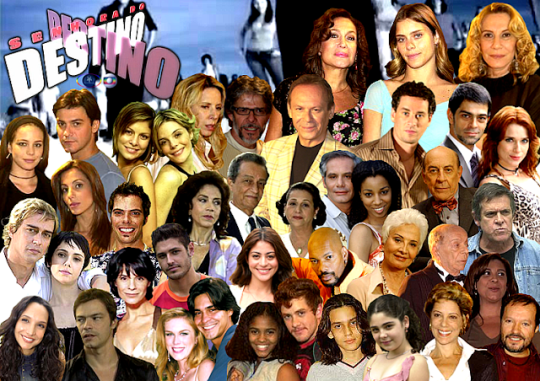

Caption: Typical cast in Telenovelas from different Latin American countries. Most actors, especially main actors are white of European descent. Light-skinned mixed descendants are the second most prominent in certain countries, in some others even they are few. People of predominate African and Indigenous ancestry are usually secondary characters or extras, often playing negative or non-essential roles.
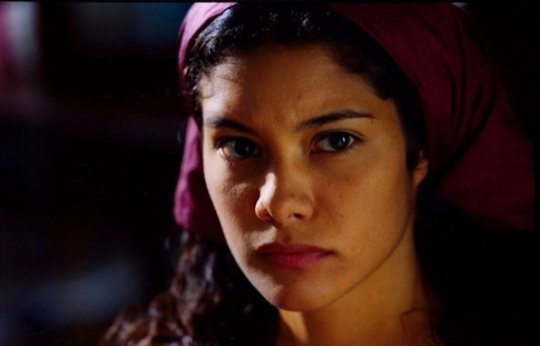

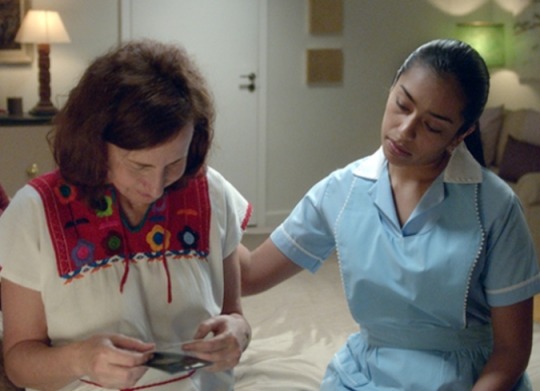
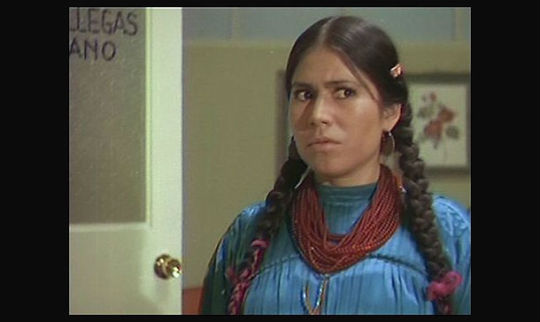





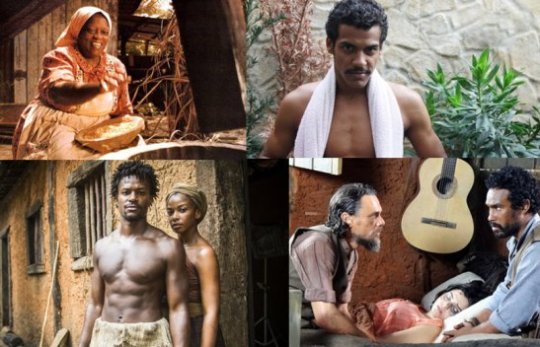


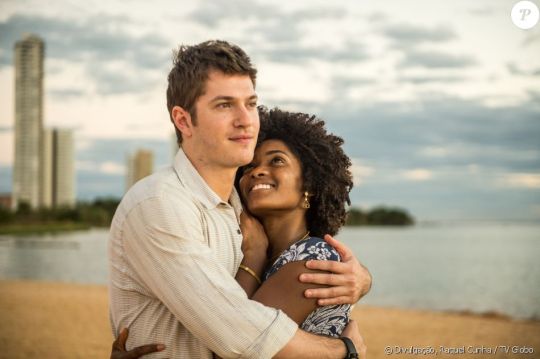

Caption: People of predominate African and Indigenous ancestry typically play maids, criminals, slaves, “non-acculturated” Indian roles (to stress that they’re “unlike us”), and other stereotypical roles. Or the role of the supporting friend to the white character. Black females whenever playing an important role, especially in Brazilian soap operas, are often portrayed as being “saved” from their condition once they find their white prince-charming, a narrative that has its origins in colonial literature.
Sometimes even stories focusing on slavery or colonization have non-Indigenous/Black actors playing them.



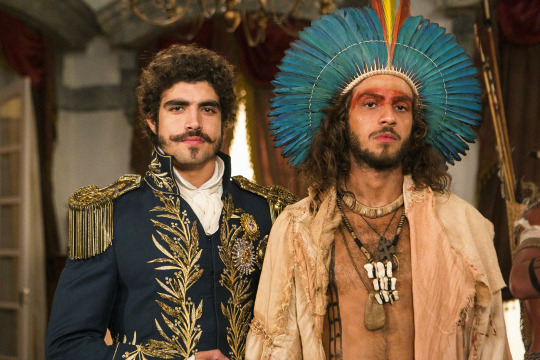

Caption: The first telenovela “White Slave” was about trans-atlantic slavery in Colombia, but the whole show was focused on a rich white girl who was sold into slavery and raised by formerly enslaved Africans who escaped to Maroon settlements. The rest of the examples are of white or light skinned-mixed-race people playing black and Indigenous characters.
Fashion
It’s not a surprise that Canada is cold, especially in the winter time, and because of this Canadians are well prepared for such a climate. The piece of fashion that I have incorporated into my own fashion while living in Canada is that of the toque (Cornell, 2012, Sept. 10). The toque is a national symbol of Canada and most Canadians wear them throughout winter. It is believed that the fashion of wearing a toque in this country started with the Bois-Doi-Couers, fur-trappers, often of Metis descent, who made up the first generation of contact between European and Indigenous people (Wikipedia contributors, 2018, June 6). This is why I think it is a quintessential item in helping me adapt both to the climate and the culture/history of this nation. The toque has had a great impact in my life by keeping me warm from the harshness of Canadian winter.


Caption: A Catalan French man wears a type of Phrygian styled hate popular in Southern France and Spain, the influence for the Canadian toque.
Food
Food? What can I tell you about my love for food and the various cuisines of the world. The GTA is one of the most multicultural regions of the world and it has one of the most diverse selections of "ethnic" restaurants, spanning from Uyghur all the way to Chifa (Chinese-Peruvian) dining establishments. Wherever I go, I can't stop myself from being influenced by ingredients and dishes from around the world, for example using loads of Angolan piri piri hot sauce in most of my meals. Toronto like my mother's native Sao Paulo share two of the largest Italian diasporas in the world, and because of this I have greatly been influenced by pasta (Veccia, 1984, pg. 4-12). Due to Italian immigration, pasta has become a staple of the cuisine of Sao Paulo, and it has impacted me greatly because it's been one of the main sources of carbohydrates in my daily life (Coughlin, 2013, Sept. 13). Interestingly enough, there are many legends and theories as to how pasta got to Italy, ranging from Marco Polo introducing it in the Middle Ages, towards the more accepted belief of early Nomadic Arabs spreading it into Europe (Avery, 2012, July 26). Which shows how vastly different cultures have been interacting with each other for hundreds to thousands of years via things like trade routes.
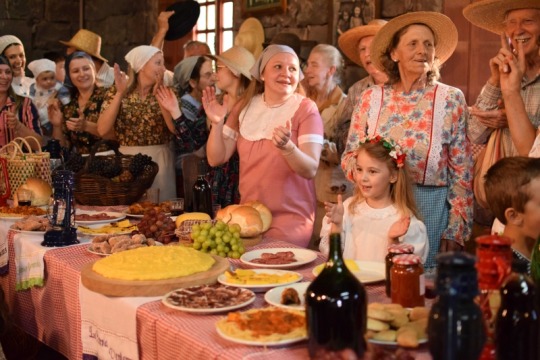
Caption: Brazilians of Italian descent during a folk festival. WIth them are popular dishes brought to Brazil by immigrants from Italy such as pastas, polenta, and cured meats.
Architecture
Studies show that architecture can have both an emotional and psychological impact on us, and I have personally known this to be true (Weller, 2016, Sept. 15). Growing up in Cuba I live on a block where houses were all attached to each other and the road was narrow. Whenever you would walk out of your house the whole street was socializing with each other; people played dominoes, had street parties, and regularly sat around socializing outside as fellow neighbours. This scenario gave me a sense of community, belonging, and a frequent dose of socialization as a child. Then, for some time, I moved to Miami in the United States to live with cousins. They lived in suburbs with wide streets, long back-yards, and houses that were quite a spatial distance from each other. These suburban designs made me feel very isolated and distanced from everyone living around me outside of my family. There wasn't the same feeling of community I felt in the densely populated neighbourhoods in Cuba, where although it could sometimes feel crowded when all the neighbours were out, it always gave me a sense of social belonging and a sense of knowing my neighbour on an intimate level. Later on, living in Canada and working in the construction industry, had once again given me a chance to encounter something that I saw as North American, due to the reason that such suburbs do not exist in my own country. However, this time around it was not the suburbs themselves, but the exurbs; which as we have learned in this unit are the result of greater urban sprawl, and a headache on our environment according to some environmentalists such as David Suzuki. In the exurbs, such as Milton, I discovered something else that had a negative psychological impact on me; tract housing. Although in Canada they're not as bad as some parts of the U.S. or places like China and the UK, they have left a horrid impression on me, due to the fact that most of them look the same and are designed in the same way. It gives a type of robotic, cold, homogenous, collective feel to them. Paradoxal, considering the very non-collective makeup of society in these types of environments (despite how they're portrayed in the media) (Preswitch, 2017, March 16).


Caption: Tract housing. This is depressing.

Caption: Markham, Ontario.
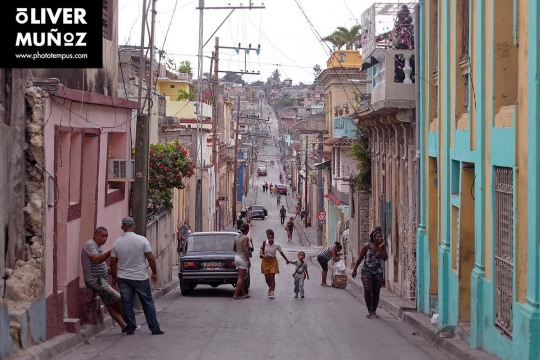
Caption: Most streets both in urban and rural Cuba are close together.


Caption: There are some rural areas with very isolated types of houses, called Bohios, with large plantations or fields for farming. These are usually occupied by descendants of Spaniard/other European peasants who were encouraged to settle in Cuba in rural areas in the 19th century, in order to inhabit areas that were very isolated and were often perfect environments for “Maroon/Palenque” runaway slave) settlements. Most of these farmers and their families have settled in less isolated rural areas where housing is similar to the urban areas or in proper urban areas.
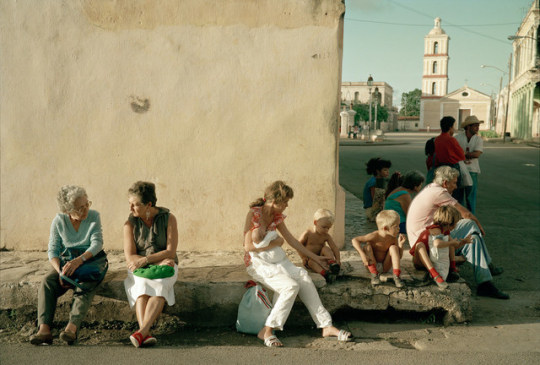

Caption: Most Cubans socialize daily on their neighbourhood street or block. Since until very recently the state owned all property, many people began making businesses from their homes. So often a local business is run on the street or inside the house of a neighbour, thus the person running the business will mostly have clients who are neighbours.


Caption: Cubans hang on their street daily. Often playing card games and dominoes in front of their houses, on the street.

Caption: Community parties and Lukumi (Afro-Cuban deity) and Catholic saint processions occur frequently among neighbours/people on the same block.
Leisure
Leisure activities with origins from around the world are another way you can experience the GTA and Canada as a whole. It's difficult to not to know an urban-dweller that hasn't partook in Japanese Karate, Afro-Brazilian Capoeira, or Hindu Yoga, and I have partaken in various forms of all three activities myself. However, the most influential forms of past-time, would have to be two from my own childhood, both activities have origins in China but have had different impacts on me growing up. Cuba has a large Chinese descended population originating from indentured labourers that were brought to the island at the end of the slave trade (Lopez, 2013, June 10, pg. 50-52). Most Cubans of Chinese ancestry have assimilated into the general population, but many of their cultural traits were infused into the general culture of the nation. Growing up in Cuba, one my best-friends was a Cuban of Chinese ancestry and he and I would often play Mahjong, which is a tile-based game that was developed in China during the Qing dynasty (Lam, 2017, July 28, pg. 11). I've mentioned before Cubans love playing dominoes, and mahjong has many similarities to dominoes. This impacted me because it created a lot of fond memories, and the nostalgia of them hit me every time I play the game in the present. Another example of a Chinese leisure activity that has a lot of popularity in Cuba is that of Tai Chi, which has origins in Taoist philosophy (Wong, 1996, pg. 3). Tai Chi is an activity my grandmother often partakes in, it brings her a lot of joy and opportunity to stay healthy in her elderly age, while being able to socialize with friends and neighbours. It has impacted me because it not only has brough such joy to my grandmother's life, but also helped me bond with her while partaking in it alongside her. In my opinion, it's a great way to get the aging baby-booming population to gather together, work on their bodies, and receive pleasure and the positive psychological benefits which are said to come from partaking in the activity.
youtube
Caption: News segment about Little China in Havana, Cuba.

Caption: Cubans of Chinese descent play mahjong

Caption: Elderly Cubans partaking in Tai Chi
Final Thoughts
In a globalized world and a multicultural region of earth that the Americas are, it's close to impossible not to partake or enjoy of a culture that is different from your own. Often, we don't realize how the socialization process might impact us. How the people and cultures we’re around could shape the way we think and behave, even if its contradictory to our own personal culture. As I have presented above, anyone living in the Americas from Canada, to Cuba, and Brazil could be influenced and impacted by the entertainment, culture, fashion, foods, architecture, and leisure activities of cultures other than their own, in the way I have been. These cultural influences on my life have made me the person that I am today, and have made me appreciate being the global citizen of the world that I am. As the world is changing and people around it open themselves up more to humanity; I hope that people are able to share their cultures more prominently. My only wish is that we go by it in another way. Because like many critics we have read about in this unit, I do unfortunately believe that when culture is globalized it can easily be warped into some type of manufactured, whitewashed, Americanized version of what it originally was. It would be unfortunate if this pattern continued. What is the solution to keep that from happening? I don't think we really have one yet..
References
Avey, Tori. (2012, July 26). Uncover The History of Pasta. Retrieved 7:26 pm., August 28, 2018. From: www.pbs.org/food/
Clarke, Colin. (2018). Mexico and the Caribbean Under Castro's Eyes: A Journal of Decolonization, State Formation and Democratization (22-24). New York City: Springer International Publishing.
Collier, Simon, Thomas Skidmore, Harold Blakemore, eds. (1992). The Cambridge Encyclopedia of Latin America and the Caribbean, 2nd ed (pg. 22-34). New York: Cambridge Univ Press.
Cornell, Kari. (2012, September 10). Knitting Hats & Mittens from Around the World: 34 Heirloom Patterns in a Variety of Styles and Techniques (pg. 5). Minneapolis, USA: Voyageur Press.
Coughlin, Jovina. (2013, September 13). South America’s Little Italies. Retrieved 7:19 pm., August 28, 2018. From: https://jovinacooksitalian.com
Lam, Desmond. (2014). Chopsticks and Gambling (pg. 11). Abingdon, UK: Routledge.
Lopez, Kathleen M. (2013, June 10). Chinese Cubans: A Transnational History (Envisioning Cuba) (pg. 50-52). The University of North Carolina Press.
McAuslan, Fiona. (2010). The Rough Guide to Cuba (pg. pg. 409-413 and 523). London, England: Rough Guides.
Moreno, Carolina. (2017, March 13). This Latina Is Calling Out Telenovelas For Being 'Overtly White'. Retrieved 05:19 pm., August 28, 2018. From: https://www.huffingtonpost.ca/entry/this-latina-is-calling-out-telenovelas
Preswitch, Emma. (2017, March 16). Canada's Seniors Live in Suburbs, And That's A Problem, Says New Report. Retrieved 8:01 pm., August 28, 2018. From: https://www.huffingtonpost.ca/2017/03/16/seniors-canada
Veccia, Theresa R. (1984). Families on the Move: Italian Emigration to Saõ Paulo, 1880-1914 (pg. 4-12). University of Wisconsin--Madison.
Weller, Chris. (2016, Sept. 15). There may be an evolutionary reason suburbia feels so miserable. Retrieved 7:48 pm., August 28, 2018. From: www.businessinsider.com/why-suburbs-are-bad-2016-9
Wikipedia contributors. (2018, June 6). Toque. In Wikipedia, The Free Encyclopedia. Retrieved 01:19, August 29, 2018. From: https://en.wikipedia.org/w/index.php?title=Toque&oldid=844733269
0 notes
Text
Hello reader, hope you are doing well. What? You are confused by the title? You think I am blabbering? No, I ain’t talking rubbish, please have a read to get the matter.
Botanical lives are beauties for sure, not to forget the innumerable benefits we derive from them. But then, just like everything has a vile side to it, the same goes with them. Let us talk about some of them.
The manchineel tree(sc. name: Hippomane mancinella). It is a flowering plant species belonging to the Euphorbiaceae family, native to the forests of tropical belt of the Americas(Caribbean, Florida, The Bahamas, Mexico, Central America, and the northern part of South America) and is dubbed to be one of the most dangerous trees on the planet. It is an evergreen tree with an average lifespan of other common tropical ones, has simple green leaves arranged alternately, barks that are a mix of red and gray and has groups of small greenish-yellow flowers which bear little fruits that look somewhat like the Indian gooseberry or green apples.
Close up of leaves and fruits.
Machineel in full foliage
So, this was how the Machineel looks. Now, about its toxicity; what parts of this tree are toxic? In one word, every. Yes, its leaves, fruits, bark, flowers all are better perceived from a distance. Eating the fruit tastes sweet at first, until minutes later they leave the consumer gasping for breath in pain. Agony starts with burning sensations down the throat and the food pipe, increasing to painful blisters inside there, vomiting and in worst cases even causes death. For all Spanish speakers reading this, the fruit has a nice little name- ” manzanilla de la Muerte “.Poisonous fruits are just the tip of the iceberg though. A milky white corrosive sap that oozes from its bark all round the year isn’t something you would like to touch.
Sap oozing out from a cut in the bark of Machineel,
It blazes skin leaving behind deep scars and rashes; two of the many harmful chemicals in it being hippomanin A and B. Also, it is not a very good idea to lit a bonfire with wood from this tree–burning them makes the toxins available for inhalation, the results of which include a headache, serious breathing troubles and eye burns to level of damaging the cornea completely. The leaves also contain this notorious poison as well as the flowers. It is known that early Caribbean tribals used to poison tips of their arrows with this sap and then wielded those arrows to kill animals in hunt or explorers ‘trespassing’ on ‘their’ land. Their enemies also sometimes found their drinking water to be poisoned with the leaves of this plant. The most famous death that can be attributed to the Machineel is probably that of the 15th-century Spanish conquistador Juan Ponce de León. He is said to have been struck by arrows coated with the poisonous sap by aboriginals on his second journey to conquer Florida, a few days after which he died out of the resultant wounds. Now Among all those who can’t stand this tree of death, there is one(known till date) lucky guy after all who has found himself immune to its toxins and thus feeds on its fruit and leaves on its branches–the black spined iguana(sc. name: Ctenosaura similis), who thus happen to be the tree’s dispersal media.
Few others also qualify to be on this brief note of mine. They are:
The spotted water hemlock(sc.name: Conium maculatum)–This highly poisonous biennial plant is found extensively in the forests and marshes of Europe, North Africa and North America. Its beautiful white flowers hold a lethal neurotoxin, cicutoxin. Death mainly comes from respiratory paralysis within 15minutes to 6hours of ingestion, depending upon the concentration of poison ingested. Most famous victim of devil’s porridge(common nickname of this plant) was Socrates, who was forced to drink Hemlock poison with his own hands during his persecution.
Fairy bells(sc. name: Digitalis purpurea)- It is a wildly growing plant found across the temperate regions of Europe and North America. Don’t be deceived by its looks. The dainty flowers that it blossoms, contain fatal cardiac poison — digoxin, earning the plant some rightful names like Dead Men’s Bells and Bloody Fingers; consuming them brings in dizziness, nausea, vomiting, convulsions and cardiac arrest.
Deadly Nightshade(sc. name: Atropa Belladonna)-Yes, the very plant, the extracts of which were once prized by women as a cosmetic product to enlarge pupils. The name which in Italian means, Beautiful Lady is not so beautiful after all–Its stems, leaves, roots, sweet tasting berries, all contain alkaloid toxins atropine and scopolamine along with 4-5 more. Symptoms of the poison ingestion are dilated pupils, blurred vision, tachycardia, hallucinations, convulsions, frequent urination, skin rashes and irregular heartbeat. Named after Atropos, the ancient Greek Goddess of fate and destiny, this has been the cause of numerous deaths all throughout history. According to legend, the soldiers of Danes were poisoned by Macbeth’s soldiers using belladonna.
Suicide tree(sc.name: Cerbera odollum)- Indicative of the name, this is a perennial tree native to the southern states of India and other South Asian countries. Statistics say, in Karnataka(A state in southern India) alone, around 50 deaths a year are attributed to this tree. It is actually the tiny seeds of its fruits that contain the poison–cerberin which upon consumption beyond a certain level causes fatal disruptions of heartbeat leading to eternal sleep. It was also used in Madagascar to inflict ordeals on criminals as punishment until banned by King Radama II as it was reportedly so excruciatingly agonizing.
Aconite(sc. name: Aconitum napellus)- Commonly known as “Wolf’s bane”, “devil’s helmet” and “queen of poisons” among many other names, is a species of genus Aconitum that hosts 249 others. All parts of this plant are poisonous, especially the roots, flowers and the fruits that house a deadly poison–Aconitine. Aconitine that is one hand used as a medicinal drug is lethal in greater quantities and raw composition. The plants in full bloom with bright purple flowers are not an uncommon site all throughout Northern Asia and Europe while their noxious characteristic has long been used by tribal hunters to apply on arrow tips and kill wolves(hence the name, Wolf’s bane), and by eskimos to kill whales. Effects of crude Aconitum from this plant start with nausea & vomiting, advancing to burns and numbness down the food pipe, sweating, dizziness and if left untreated brings the eater to death by stopping his/her heart altogether after acute hypotension and arrhythmia. It is said that Nazis used this poison to tip bullets and kill people during the 2nd world war.
With this, I end my article this time. Stay well, stay happy and do stay away from these greens. If you feel some name(s) that ought to be on this list, feel free to leave a comment. See you next time.
_____Rupsha.
Green danger zone Hello reader, hope you are doing well. What? You are confused by the title? You think I am blabbering?
#Beware#bloggerRupsha#Dangerous#Death#Euphorbiaceae#Hippomane macinella#Indian Blogger#Machineel#No Purpose#Poisonous plants#Tropical trees
0 notes